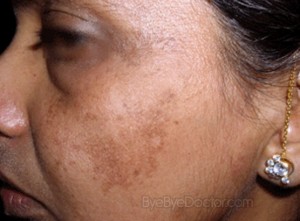Melasma/Dyschromias
 Dyschromia or dyspigmentation is a relatively common skin condition, particularly among individuals with darker skin color. Dyschromia refers to an alteration of the color of the skin or nails. “Hyperchromia” can refer to hyperpigmentation, and “hypochromia” can refer to hypopigmentation. Melasma is a form of dyschromia that is usually triggered by hormonal changes, particularly among women who are pregnant or are on estrogen-based oral contraceptive. Melasma is a pigment disorder more common in black, Hispanic and Asian individuals. It has been linked to genetic factors, as well as exposure to UV radiation. It is characterized by irregular light-brown to gray-brown patches more often on the face, including the cheeks, nose and forehead regions, but also seen on the chest and arms. To treat these pigment disorders, patients often seek out over-the-counter, herbal and prescription bleaching, fading and lightening creams at beauty supply stores and various pharmacies, but, unfortunately, use of these agents are usually not monitored appropriately by a dermatologist and can have side effects.
Dyschromia or dyspigmentation is a relatively common skin condition, particularly among individuals with darker skin color. Dyschromia refers to an alteration of the color of the skin or nails. “Hyperchromia” can refer to hyperpigmentation, and “hypochromia” can refer to hypopigmentation. Melasma is a form of dyschromia that is usually triggered by hormonal changes, particularly among women who are pregnant or are on estrogen-based oral contraceptive. Melasma is a pigment disorder more common in black, Hispanic and Asian individuals. It has been linked to genetic factors, as well as exposure to UV radiation. It is characterized by irregular light-brown to gray-brown patches more often on the face, including the cheeks, nose and forehead regions, but also seen on the chest and arms. To treat these pigment disorders, patients often seek out over-the-counter, herbal and prescription bleaching, fading and lightening creams at beauty supply stores and various pharmacies, but, unfortunately, use of these agents are usually not monitored appropriately by a dermatologist and can have side effects.
